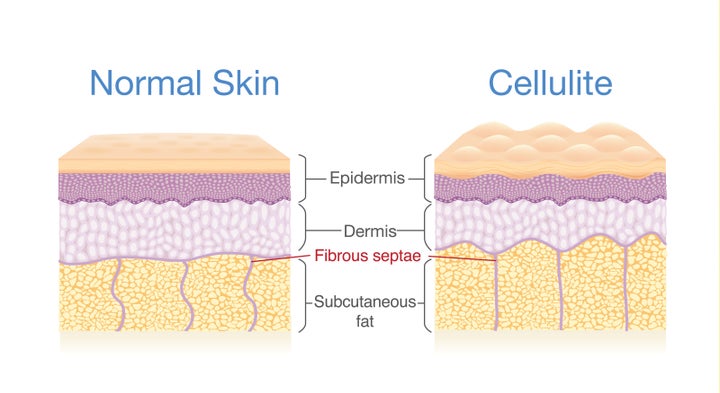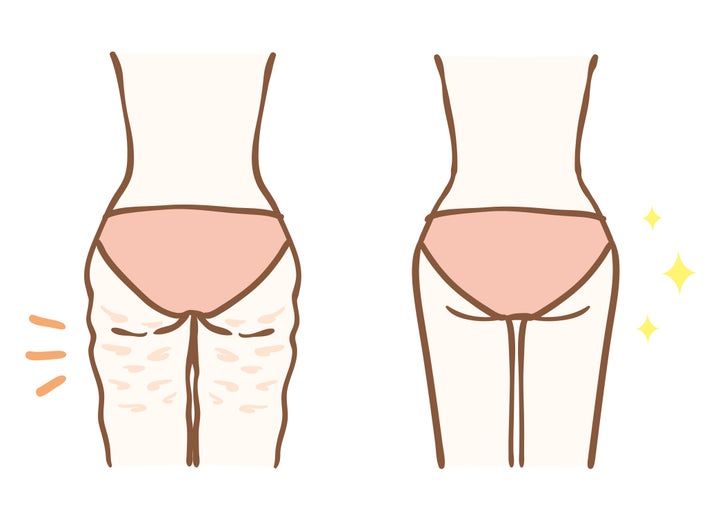Up to 90% of women have cellulite ― and Demi Lovato even wants to rebrand it as #celluLIT, suggesting we all embrace our healthy bodies. But with a plethora of affordable drugstore options out there, erasing those dimples seems so easy, right?
Jergens, Nivea and Palmer’s Coco Butter all offer firming lotions under $10 at major retailers like Target, Walgreens and Ulta. Luxury brands like Clarins, Dr. Brandt and Once Ocean Beauty offer applications claiming to reduce the appearance of cellulite, ranging in price from $40-$125.
Are any of these products effective at all?
“Topical creams are really confusing because it’s a multi-billion dollar market and many of those things don’t work,” Zakia Rahman, a dermatologist with Stanford Health Care, told HuffPost. Let’s find out whether any of those topical creams actually work.
Topical Ingredients That Work (And How Effective They Are)
Cellulite forms when the connective tissues (made of collagen) between your muscle and skin squeeze fat cells toward your epidermis, creating a bumpy, dimpled appearance.
“We know there are two topicals that have evidence that they do work for cellulite, and one is retinol.” Tretinoin (a vitamin A derivative) can be found in Retin-A, Tazorac or 1% Differin gel, and “can help because they can stimulate collagen production and make the appearance of cellulite less,” Rahman said.

The American Academy of Dermatology suggests that lotions and creams containing at least .03% retinol will be the most effective, but most don’t disclose their percentage on the label. According to Dermstore, that means the concentration likely falls under .25%. Paula’s Choice Retinol Skin-Smoothing Body Treatment ($29), for example, only contains .01 concentration, and therefore won’t do much to reduce the appearance of dimples and waves.
The second topicals that may work are caffeine-related products, which can help the appearance of cellulite. “They reduce the size of the fat cells and promote the breakage [of fibrous bands of connective tissue],” Rahman said.
If you don’t see caffeine listed on products that claim to reduce cellulite, try to find methylxanthine, which encompasses caffeine, aminophylline and theophylline. Though beloved Palmer’s Cocoa Butter Formula Firming Skin Butter boasts plenty of cocoa — plus shea butter — it lacks caffeine. Nivea’s Skin Firming Hydration Body Lotion touts shea butter as well, but neither caffeine or retinol.
Jergens’ firming lotion also lacks caffeine or retinol, as does Clarins’ $106 Body Fit Anti-Cellulite Contouring Expert cream-gel, which claims to “visibly firm, lift and streamline thighs and hips” with the help of “eight targeted plant extracts.” With a $248 price tag, Cellulinov’s Intensive anti-cellulite body care combines longan seed, red algae and Indian lotus extracts with caffeine and cedrol (a skin conditioning agent). In terms of results, it states, “the appearance of cellulite appears visibly reduced.”
The repeated use of the word “appear” says it all: Things aren’t always how they look on the outside. Some products, like InstaNatural Crepe Skin Firming Cream ($35) and Rosen Apothecary Anti-Aging Retinol Body Lotion ($17), boast both ingredients, but that still doesn’t ensure a lasting reduction in the appearance of orange peel-looking skin.
A 2018 International Journal of Dermatology study examining the effectiveness of lotions from Bliss, Clarins, Shisheido and Glytone found “they are rarely effective on cellulite.”
Rahman listed four goals for addressing cellulite: Shrink fat cells, break apart fibrous bands of connective tissue (which she said no topical creams can do), remodel the top layer of skin and reduce inflammation.
“Those things may temporarily reduce the appearance of cellulite,” Rahman said. Key word: temporarily.
How Diet And Exercise Factor In
Visible cellulite is possible even for people with very low body-fat percentages, so cutting back on your fat intake won’t necessarily help everyone.
But reducing inflammation through diet is a possibility. “An anti-inflammatory diet basically comes down to a healthy diet,” Navar said. “Stay away from refined carbohydrates, sugar and processed meats. Stay away from artificial sweeteners — anything that says diet on it is basically artificial. And also stay away from trans fats, anything that’s packaged with a long shelf life, like cookies candies, and chocolates.”

When it comes to shrinking fat cells that contribute to cellulite, hitting the gym can help. However, “There isn’t one thing that we can do to say, reduce cellulite on your left thigh,” ACE-certified trainer Jacque Crockford told HuffPost. “Physical activity in general will help increase blood flow and increase stimulation of tissue, the type of things which play a role in cellulite. However, there is no one type of exercise to do to reduce cellulite overall.”
High-Tech Cellulite Treatments
As we know, you can’t outrun genetics. “I have women who come in for cellulite treatments that run marathons, that have done all kinds of exercise and they’re thin as a rail and they still have cellulite,” Bruce Katz, director of the JUVA Skin & Laser Center in New York City, told HuffPost. “With cellulite, it’s really a genetic thing.”
Katz said one-time treatments like Cellulaze or Selfina result in more effective and permanent cellulite removal than creams can provide. “The way Selfina works is a suction device attaches to the dimple and a little blade goes under the skin and breaks up the little fibrous bands that pull down and cause the dimples,” he said. “You get some bruising and swelling after, but this has worked for dimples with lasting results.”
Cellulaze “is the one treatment that’s really stood the test of time,” Katz said. The laser treatment “cuts the fibrous bands that pull down and cause the dimples and also melts the fat that’s causing the waviness,” he continued. “The third component addresses the dermis because most women who have cellulite have laxity of the dermis, so the laser stimulates collagen to tighten the skin.”
Acoustic Wave Therapy serves as a non-invasive treatment alternative, but, “it requires five to six treatments and maintenance, so it’s not a long-lasting result,” Katz said.
So … Are Creams Worth Your Money?
Still, the invasive treatments offer the most effective and long-term results. In terms of topical treatments, “there’s not really much you can do,” Katz said. “Different types of creams that have been used — caffeine creams, retinols — none of them have shown to have any significant benefits.”
So while using over-the-counter lotions, creams and serums seems like the cheaper option (Katz notes the procedures aren’t covered by insurance), to see even a small, temporary reduction in the cottage cheese-like appearance of cellulite, you’d need to apply products consistently over an extended period of time.
“It’s unlikely to have an effect in a very short term, so I would say at least a six-month window before you give up on a treatment,” Rahman said. “Patience, unfortunately, is necessary for a lot of these topical treatments.”
The best alternative, of course, would be to love the body you’re in, take care of it to keep healthy, and appreciate all that it does for you.
Credit: Source link